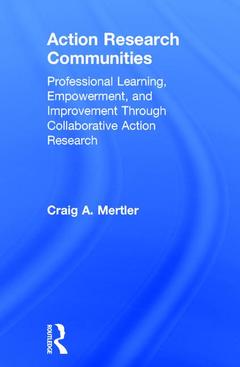Action Research Communities Professional Learning, Empowerment, and Improvement Through Collaborative Action Research
Auteur : Mertler Craig A.

Action Research Communities presents a new perspective on two current and proven educational practices: classroom-/school-based action research and professional learning communities. Implementation of one or the other of these practices often results in a variety of possible benefits for the teaching?learning process, for student achievement, and for overall school improvement. While these might seem to be separate, isolated practices, the author has taken the beneficial aspects of each practice and merged them into a cohesive and potentially powerful concept, coined "action research communities."
Each of the two concepts or approaches (action research and professionallearning communities) is presented and discussed in detail. Because they both focus on local-level improvement of educational practice and share several overlapping features, the two concepts are then merged into a single entity?action research communities, or ARCs. These professional learning communities, with action research at their core, hold an immense amount of power and potential when it comes to enhanced professional growth and development for educators, increased student achievement, school improvement, and educator empowerment. ARCs essentially capitalize on all the individualized benefits and strengths of action research and of professional learning communities, and merge them into a single educational concept and practice. ARCs have the potential to help educators everywhere experience:
?a common and collective focus and vision;
? sustained collaborative inquiry;
?individualized, customizable?and meaningful?professional growth; and
?true empowerment that comes with this form of collaborative, inquiry-based, and reflective practice.
Practical guidance for the development and implementation of ARCs is also provided, by focusing on ways in which professional educators (teachers, administrators, support staff, etc.) can implement, sustain, and extend the impact of their respective action research communities. Specific roles for district administrators, building administrators, and teachers are presented and discussed in depth, as are ways that ARCs can be used both to deepen professional learning for educators and to improve student learning.
Introduction: Why Merge Action Research and Professional Learning Communities?
Introduction: Why merge action research and professional learning communities?
1: What is Action Research?
Description of Action Research
Action Research vs. Educational Research
What Action Research Is and Is Not
Professional Benefits of Action Research
The Process of Conducting Action Research
The Process in Action — An Example
Step 1: Identifying and limiting the topic
Step 2: Gathering information
Step 3: Reviewing the related literature
Step 4: Developing a research plan
Step 5: Implementing the plan and collecting data
Step 6: Analyzing the data
Step 7: Developing an action plan
Step 8: Sharing and communicating the results
Step 9: Reflecting on the process
Important Takeaways from Chapter 1
2: Professional Learning Communities
What is a Professional Learning Community?
Characteristics of PLCs
Shared Mission, Vision, Values, and Goals
Collaborative Culture with a Focus on Learning
Collective Inquiry into Best Practice and Current Reality
Action Orientation: Learning by Doing
Commitment to Continuous Improvement
Orientation Focused on Results
The Challenge of a Changing Culture
Teaching and Assessing in a PLC
Important Takeaways from Chapter 2
3: The Action Research Model for Transformational Innovation
What is the Action Research Model for Transformational Innovation?
The Five Components of the Model
Data-Driven Educational Decision-Making
Data, Data, and More Data
Thinking Differently
Collaboration
Professional Reflection
One Additional (Sub)Component…
Implications of the Action Research Model for Transformational Innovation
Important Takeaways from Chapter 3
4: Putting It All Together: Action Research Communities
TI-in-Ed + PLC = ARC
Specifying the Purposes and Functioning of an ARC
Roles for Teachers in ARCs
Roles for Building Administrators in ARCs
Roles for District Administrators in ARCs
Important Takeaways from Chapter 4
5: Where Do We Go From Here? Sustaining and Growing Your ARC
Ways to Sustain ARCs
Link Reform Efforts to Existing Practices
Focus on "Why," Then on "How"
Align Actions with Words
Be Flexible, but Firm
Build a Coalition, But Don’t Wait for Unanimity
Expect Mistakes…and Learn from Them
Learn by Doing, Not by Additional Training
Short-Term Victories…and Celebrations
Ways to Extend ARCs
Integrating Technology
Student Engagement
Grant Funding
Mini-Grants to ARC Participants
Systems of Incentives
Components of Personnel Evaluation Systems
Action Research / Innovation Conferences
Implementation of an ARC Represents a Process
Important Takeaways from Chapter 5
6: Using ARCs to Deepen Professional Learning and Improve Student Achievement
Action Research Communities as Mechanisms for Professional Learning
Action Research Communities as Mechanisms for Improving Student Achievement
Important Takeaways from Chapter 6
References
Appendix: Action Research Mentor Portfolio Templates
Index
Craig A. Mertler is an Associate Professor and Director of the EdD Program in Leadership & Innovation at Arizona State University. He has been an educator for 32 years, 22 of those in higher education, and 6 as an administrator. He is the author of 22 books, 8 invited book chapters, and 20 refereed journal articles.
Date de parution : 08-2017
12.9x19.8 cm
Disponible chez l'éditeur (délai d'approvisionnement : 14 jours).
Prix indicatif 129,87 €
Ajouter au panierDate de parution : 08-2017
12.9x19.8 cm
Disponible chez l'éditeur (délai d'approvisionnement : 14 jours).
Prix indicatif 25,19 €
Ajouter au panierThème d’Action Research Communities :
Mots-clés :
Professional Development; Action research; School Wide Faculty Meetings; Communities; Professional Learning Community; K-12; Action Research Communities; Teaching; Mixed Methods Research Studies; Qualitative; Collaborative Action Research; Research methods; School Based Action Research; Craig Mertler; Action Research Model; Meaningful Professional Development; Personnel Evaluation Systems; District Level Administrators; Action Research Studies; Transformational Innovation; Reflective Practice; Conduct Action Research; Action Research Process; Quantitative Research; Classroom Based Action Research; Traditional Educational Research; Online Professional Development Modules; Improved Academic Achievement; Student Engagement; Backward Approach; PLC School; PLC Process



